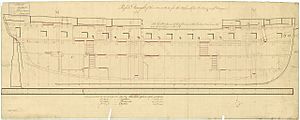HMS Banterer (1807) facts for kids

Banterer
|
|
Quick facts for kids History |
|
|---|---|
| Name | HMS Banter |
| Ordered | 30 January 1805 |
| Renamed | HMS Banterer 9 August 1805 |
| Builder | Temple shipbuilders, South Shields |
| Laid down | August 1805 |
| Launched | 24 February 1807 |
| Completed | 12 July 1807 |
| Commissioned | May 1807 |
| Out of service | Wrecked 29 October 1808 |
| General characteristics | |
| Class and type | 24-gun Banterer-class sixth-rate post-ship |
| Tons burthen | 53774⁄94 (bm) |
| Length |
|
| Beam | 32 ft 0.5 in (9.8 m) |
| Depth of hold | 10 ft 6 in (3.20 m) |
| Sail plan | Full-rigged ship |
| Complement | 155 (later 175) |
| Armament |
|
HMS Banterer was a warship that belonged to the Royal Navy, the navy of the United Kingdom. It was a "sixth-rate post-ship," which means it was a smaller type of warship. Banterer had 24 guns and was built in South Shields, England, between 1805 and 1807. The ship was first ordered as HMS Banter, but its name was changed to Banterer on August 9, 1805.
Banterer was designed to carry 24 main guns, which were 9-pounder cannons. It also had other weapons, like eight 24-pounder carronades and two 6-pounder guns. These were placed on the ship's upper decks.
Later, the British Admiralty, which managed the Royal Navy, decided to change some of the ship's weapons. They replaced the 9-pounder cannons with more powerful 32-pounder carronades. They also added two brass howitzers. Because of these changes, the ship needed more sailors. Its crew grew from 155 to 175 officers, men, and boys.
The building of Banterer started in August 1805. It was officially launched into the water on February 24, 1807. The ship was fully finished and ready for duty by July 12, 1807.
Life at Sea: Banterer's Service
Captain Alexander Shippard was the first commander of Banterer. He took charge of the ship in May 1807.
One of the first important events for Banterer was the Battle of Copenhagen. This battle took place in August and September of 1807. Banterer played a part in this major naval event.
After the battle, Banterer returned to England. In February 1808, it set sail again. This time, it was part of a group of ships, called a convoy, heading to Halifax, in British North America (which is now part of Canada).
The Final Voyage and Investigation
On October 29, 1808, Banterer was sailing in the Saint Lawrence River in British North America. Sadly, the ship was wrecked near a place called Point Mille Vache.
After the shipwreck, an official investigation was held. This was a court-martial, a special military court. It took place aboard another ship, the Tourtourelle, in St. George's Harbour in Bermuda. The court-martial happened between January 28 and 30, 1809.
The court looked into what caused the shipwreck. They decided that Lieutenant Stephen C. McCurdy was responsible for not doing his job properly during his watch. He was removed from the Royal Navy. The acting master, Robert Clegram, was also criticized. He had been careless and didn't pass on important safety instructions to the officer who took over from him.
However, Captain Shippard and the other officers and crew members were found not responsible for the loss of the ship. The pilot, who guided the ship, was also cleared of blame.

